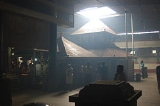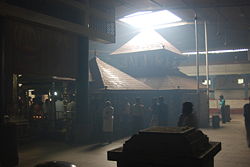
Kateel
Encyclopedia

/Kannada: ಕಟೀಲು) is a temple town in the Dakshina Kannada
Dakshina Kannada
- Geography :The district geography consists of sea shore in the west and Western Ghats in the east. The major rivers are Netravathi, Kumaradhara, Phalguni, Shambhavi, Nandini or Pavanje and Payaswini which all join Arabian sea. Vast areas of evergreen forests which once covered this district, have...
district of Karnataka
Karnataka
Karnataka , the land of the Kannadigas, is a state in South West India. It was created on 1 November 1956, with the passing of the States Reorganisation Act and this day is annually celebrated as Karnataka Rajyotsava...
, India
India
India , officially the Republic of India , is a country in South Asia. It is the seventh-largest country by geographical area, the second-most populous country with over 1.2 billion people, and the most populous democracy in the world...
. It is about 29 kilometers away from Mangaluru
Mangalore
Mangalore is the chief port city of the Indian state of Karnataka. It is located about west of the state capital, Bangalore. Mangalore lies between the Arabian Sea and the Western Ghat mountain ranges, and is the administrative headquarters of the Dakshina Kannada district in south western...
and is considered one of the holiest temple towns in Hinduism
Hinduism
Hinduism is the predominant and indigenous religious tradition of the Indian Subcontinent. Hinduism is known to its followers as , amongst many other expressions...
. The main attraction of the town is the temple of Sri Durga Parameshwari
Shakti
Shakti from Sanskrit shak - "to be able," meaning sacred force or empowerment, is the primordial cosmic energy and represents the dynamic forces that are thought to move through the entire universe in Hinduism. Shakti is the concept, or personification, of divine feminine creative power, sometimes...
.
The holy temple is situated on an islet in the middle of the sacred river Nandini amidst panoramic scenes and fascinating greenery. Thousands of devotees visit Kateel every day to seek blessings from goddess Durga Parameshwari.
Origins of Kateel
There is a story behind this spiritual place. A severe drought once hit this place and it did not rain for years. Even BrahminBrahmin
Brahmin Brahman, Brahma and Brahmin.Brahman, Brahmin and Brahma have different meanings. Brahman refers to the Supreme Self...
s were forced to eat meat and people were on the verge of giving up their principles. The great Sage Jabali was disturbed by this situation. Through his 'Jnana Drishti' (divine vision), Jabali realized the root cause of all this. He found that Arunasura, the 'rakshasa
Rakshasa
A Rakshasa or alternatively rakshas, is a race of mythological humanoid beings or unrighteous spirit in Hindu and Buddhist religion...
', who had escaped from death and fled when Goddess Durga killed Shumbhasura, had increased his life span by following the teachings of his Guru. He had forcefully stopped people from performing any yagas or yajnas as a revenge against the 'devas', and this has resulted in drought and scarcity for years.
Jabali wanted to put an end to human sufferings and decided to perform a yajna to please the devas. He requested Devendra
Indra
' or is the King of the demi-gods or Devas and Lord of Heaven or Svargaloka in Hindu mythology. He is also the God of War, Storms, and Rainfall.Indra is one of the chief deities in the Rigveda...
to permit him to take Kamadhenu
Kamadhenu
Kamadhenu , also known as Surabhi , is a divine bovine-goddess described in Hindu mythology as the mother of all cows. She is a miraculous "cow of plenty" who provides her owner whatever he desires and is often portrayed as the mother of other cattle as well as the eleven Rudras...
, the holy cow, for the yajna. Devendra asked Jabali to take Kamadhenu's daughter Nandini instead. Nandini refused to accompany Jabali to earth since evil was predominant there. After a lot of arguments, Jabali, in his anger, cursed that she be born as a river on earth. Realizing her mistake, Nandini prayed for mercy. Relenting, Jabali advised her to pray to Goddess Durga to redeem her from the curse, Nandini appealed to Goddess Durga who appeared to her and informed her that though Nandini would be born as a river in fulfillment of the curse, she, Durga herself, would be born as Nandini's daughter at the center of the river, and in the process, Nandini would attain purification. On Magha shudda Poornima, Nandini emerged as a river from Kanakagiri. Jabali performed his yajna. The devas were pleased and the earth was once again happy.
Elsewhere Arunasura acquired a boon from Brahma that he would not suffer death from any two legged or four legged being or from any weapon. Brahma also powered him with the Gayatri
Gayatri
Gayatri is the feminine form of , a Sanskrit word for a song or a hymn. Gayatri is a consort of Brahma and the goddess of learning. Brahma married her when there was a need for a companion during a yajna. Brahma had to start the yajna along with his wife...
Mantra. After acquiring these powers, Arunasura defeated the devas and conquered heaven. The Devas prayed Goddess Durga for help.
One day Goddess appeared in Arunasura's garden as a beautiful woman. Seeing the lady, Arunasura approached her. The beautiful lady reminded him that she had killed Shumbhasura and from whom Arunasura had escaped death. Arunasura got angry and tried to kill the woman with sword. The Goddess suddenly turned into a stone. Arunasura slashed the stone with the sword, then a vast swarm of bees emerged from the stone and stung him.
The bees (dhumbi) stung him repeatedly till his last breath. Devas led by Jabali performed abhisheka with tender coconut water and requested the Bhramarambika (Queen of the bees) to bless the world. Goddess Durga then appeared in her 'Soumya Roopa' (calm form) in the middle of the river, where the present structure of the temple imparts its glory to the world. In Samskrutam
Sanskrit
Sanskrit , is a historical Indo-Aryan language and the primary liturgical language of Hinduism, Jainism and Buddhism.Buddhism: besides Pali, see Buddhist Hybrid Sanskrit Today, it is listed as one of the 22 scheduled languages of India and is an official language of the state of Uttarakhand...
(is true for other Indian languages originated from it) language, 'Kati' means 'center' (midway between the 'Kanakagiri' the place where the river was born, and the end, Pavanje, where the river joins the sea) and 'Ila' means area (land). Thus the place is called 'Kati + lla' Kateel.
Temple Trust
The temple's trust also encourages several forms of arts. Notable among them is the YakshaganaYakshagana
Yakshagana is a musical theater popular in the coastal and Malenadu regions of Karnataka, India. Yakshagana is the recent scholastic name for what are known as kēḷike, āṭa, bayalāṭa, bayalāṭa, daśāvatāra . It is believed to have evolved from pre-classical music and theatre during Bhakti movement...
, dashavathara mela which was started as an offering to the goddess. During dussera, navaratri and other annual celebrations several sacred rituals like, Chandika havana, thula bhaara, veda parayana, hari kathas etc. are performed.

